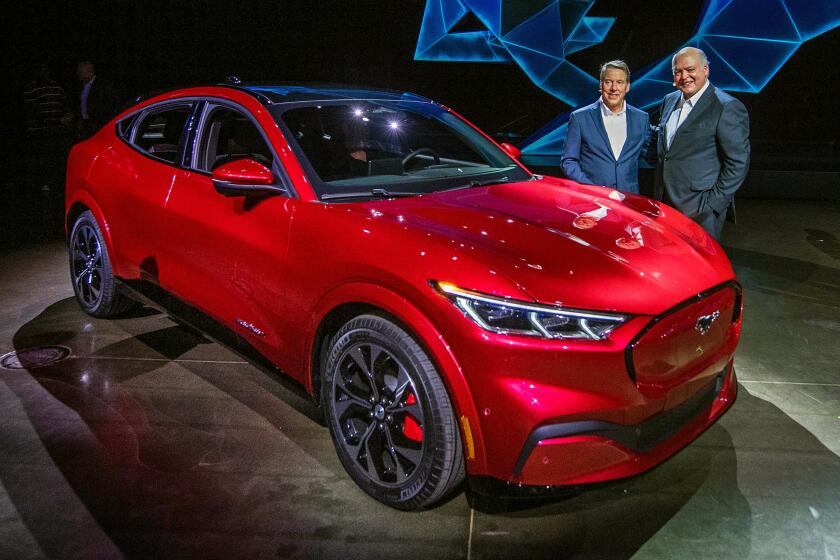Ford unveils the F-150 Lightning. Will truck buyers take to electric pickups?
- Share via
Ford Motor Co.’s new all-electric pickup truck will arrive next year having already secured one notable admirer. “This sucker’s quick,” President Biden said from behind the wheel in Dearborn, Mich., on Tuesday after a high-torque off-the-line blast in a pre-production F-150 Lightning.
Although a classic car lover, Biden is a climate hawk whose aggressive goals for cutting greenhouse gas emissions will require large-scale electrification of U.S. transportation. So count him as receptive. The company also expects young, tech-savvy buyers to be early customers of the Lightning, set to go on sale in mid-2022.
But for Ford to achieve long-term success with its new electric line, it must eventually win over customers who think like Stan Nixon and Scott David, loyal F-series customers for decades, who must be persuaded to trade in their internal combustion engines when it’s time to buy their next truck.
Nixon lives in rural Linden, east of Sacramento. He runs a roof truss manufacturing company with his son, and cultivates 80 acres of grapes. “Probably my last four trucks have been Fords,” he said. “I switched to Chevy once but went back to Ford. The Chevy rode better, but it wasn’t tough enough.”
Nixon, 70, isn’t convinced electric trucks will be tough enough. He’s worried about range, charging times and a paucity of electric charging stations. “Sometimes I have to take runs to Reno, and I’d probably have to stop and charge up,” he said. Given that he carts around roof trusses on trailers, he has another big concern: “I know electric vehicles are fast, but I’m not sure they have the pulling power.”
Ford will have to persuade him otherwise.
David, 64, is a home-building contractor in Monee, Ill. An F-150 loyalist, he nonetheless likes the idea of an electric truck. “My nephew came over in his Tesla and gave me a ride in it,” he said. “Man, that thing was fast. And fun to drive. I’d love a truck that’s fun to drive.”
But work comes first. “I need an 8-foot bed. Plywood comes in 8-foot sheets, and I don’t want them sticking out of the tailgate.”
The first Lighting comes with only a 6-foot bed.
Older buyers such as Nixon and David aren’t the prime target for the electric pickup’s first generation, but Ford knows it needs to take seriously the concerns of experienced F-series stalwarts to appeal to anybody contemplating an electric pickup truck, especially for work use. “Our marketing team is busy crafting that campaign,” said Kumar Galhotra, president of Ford’s Americas & International Markets Group.
Ford has some time, said Jessica Caldwell, auto analyst at Edmunds. “In the long term this will be crucial for Ford” as government regulations and young buyer tastes force motor vehicle makers to go electric. “For the next few years, not so much.”
Still, Ford aims to galvanize its customer base with Lightning and hopes to add to it. The base is huge. The F-series has been around since 1948 and became the U.S. market’s bestselling pickup truck in 1977 and the country’s bestselling passenger vehicle of any kind in 1981, a record it’s kept to this day. In pre-pandemic 2019, Ford sold nearly 900,000 F-series pickup trucks.
Ford is focused on two main groups for the first Lightning: what it calls young adopters drawn to new technology and commercial buyers concerned about cost.
There were doubters at Ford several years ago when the company started its market research into electric pickup trucks, said Ted Cannis, who headed Ford’s electrification efforts and now runs its North American commercial group. “Who would want an electric pickup truck? That was common at Ford,” he said.
The completely redesigned Ford F-150 is now an office, workshop and entertainment center, powered by a hybrid engine that may win over aficionados.
The company met with pickup owners at Starbucks coffee shops around the country and showed them cardboard mockups of what would become the Lightning. According to Ford, the “frunk” was a big hit.
A frunk, or front trunk, is a fringe benefit of eliminating a space-hogging internal combustion engine. The Lightning’s frunk measures just over 14 cubic feet. That’s a lockable spot for tools and more. “I want to put golf clubs, my guns, groceries in there,” potential customers told the market research team, Cannis said.
Ford will offer over-the-air fleet management services on its all-electric E-Transit vans. Construction workers will be able to plug in their power tools to the battery.
Questions about range were also common. The new five-seat Lightning, with a base price of $40,000, comes in two versions, a standard model with a range targeted at 230 miles and an extended-range version at 300 miles.
The base price is lower than that of most other electric pickups expected to be released over coming months and years. That’s because of the tremendous economies of scale that Ford gets by sharing body components with the internal combustion F-150s, put together on the same body assembly lines.
The Lightning comes standard with two motors, one on each axle, with 775 pound-feet of torque. Tesla says its upcoming Cybertruck with a two-motor drive comparable to the Lightning‘s will cost $50,000 before options. Startup Rivian’s electric pickup, with motors at each wheel, will go for about $70,000. The General Motors Humvee electric will come in four packages, with a base price ranging from $80,000 to $113,000. (The most expensive version is set for release this fall.) The Lightning is aimed square at the mass market.
That’s true for Ford’s other EV offerings: the so far well-received Mustang Mach-E and the electric version of Ford’s market-leading commercial vans. “We’re going to lean into our icons,” Cannis said.
Ford turns to electrified pickups, performance cars and SUVs to meet California’s greenhouse gas regulations.
He expects all those competitors and others will attract customers, even the odder-looking ones such as the Cybertruck, which he said will appeal to buyers who want to “show off” but not so much to those who use their vehicles for work.
“Our truck looks like an F-Series,” Cannis said. Ford customers “want it to be innovative but want it to look like a pickup truck.”
Ford has 2,300 certified dealers in the U.S., including 650 that sell and maintain commercial vehicles, he said.
The Lightning battery will be bidirectional, meaning it can serve the role of a generator to keep a house running when the power goes out. Electric power will be available to power up tools and charge their batteries at work sites and campsites.
The truck will operate with a smartphone key, and software updates will be delivered to the vehicle over the air. The company’s new BlueCruise hands-free highway driving feature is an option.
As to electric skeptic Nixon’s concerns about pulling power, Ford said the Lightning can tow a trailer and its load up to 7,700 pounds in the standard-range model and 10,000 pounds in the extended range. Maximum payload is 2,000 pounds and 1,800 pounds, respectively.
Cannis said the vehicle has undergone harsh testing in extreme environments, from sticky tar sands in Alberta, Canada, to Michigan’s severe winter roads. A steep incline test at Iowa Hill near Colfax, off Interstate 80 west of Lake Tahoe, caused the company to reconfigure the truck’s cooling system to handle the strain. Enough vehicle weight was reduced to apply a steel plate below the battery for extra protection, Cannis said.
Ford did not say how fast the thing will go. President Biden timed his own drive and reported unofficial zero-to-60-mph performance of 4.4 seconds.
More to Read
Inside the business of entertainment
The Wide Shot brings you news, analysis and insights on everything from streaming wars to production — and what it all means for the future.
You may occasionally receive promotional content from the Los Angeles Times.












